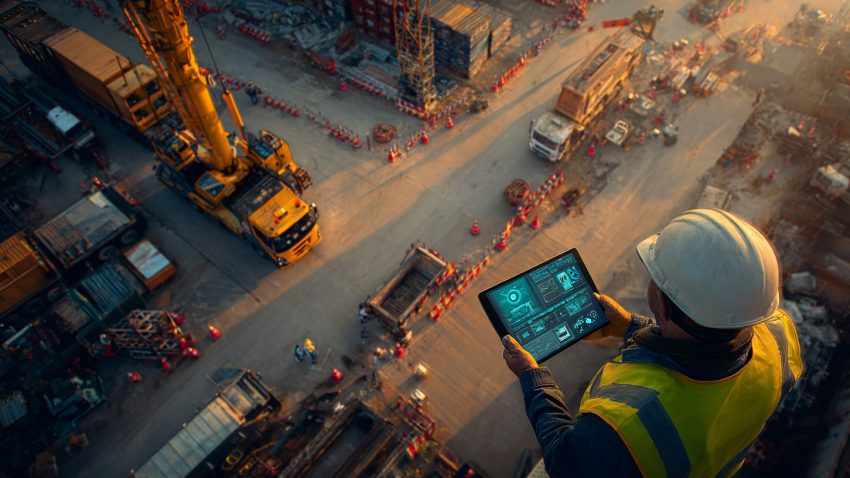AI and Sustainable Construction: How Superintendents Can Implement Environmentally-Friendly Practices
Table of Contents:
Hello and welcome to the exciting intersection of AI and sustainable construction! As we delve deeper into the 21st century, it’s becoming increasingly clear that the construction industry plays a pivotal role in shaping the health of our planet. For superintendents like you, this presents a unique opportunity to be at the forefront of an eco-friendly revolution. By integrating AI into your construction practices, you can lead the charge in reducing environmental impact while still achieving top-notch results. Let’s explore how AI is not just a tool for efficiency, but a catalyst for sustainable change in the construction sector

The Urgency of Sustainable Construction
The construction industry is one of the largest consumers of raw materials and energy, and it significantly contributes to carbon emissions worldwide. As environmental concerns become more pressing, there’s a growing need to rethink traditional construction practices. Sustainable construction is no longer a ‘nice-to-have’ but a necessity for the well-being of our planet.
AI as a Game Changer in Eco-Friendly Practices
Enter Artificial Intelligence – a technological marvel that has the potential to transform the construction industry into a model of sustainability. AI’s ability to process and analyze vast amounts of data makes it an invaluable ally in making eco-friendly decisions. From optimizing resource use to enhancing energy efficiency, AI can guide superintendents in making smarter, greener choices.
A Holistic Approach to Green Construction
Sustainable construction is not just about using eco-friendly materials. It encompasses a holistic approach to building, where every stage of the construction process is optimized for minimal environmental impact. This is where AI comes in, offering insights and solutions that respect the environment without compromising on quality or efficiency.
12 Ways of Implementing AI in Construction for a Greener Future
Now, let’s expand on the ways AI can be leveraged for sustainable construction practices, adding seven more to our initial list.
1. Use AI for Efficient Design
AI tools can help you design buildings that are not only aesthetically pleasing but also environmentally friendly. These tools can suggest designs that optimize natural light, reduce heat loss, and use renewable energy sources more effectively.
2. AI-Driven Waste Management
Implement AI systems that can help manage waste more effectively. These systems can identify the most efficient ways to recycle and dispose of construction waste, significantly reducing the environmental impact.
3. Monitor Environmental Impact
Use AI to continuously monitor the environmental impact of your construction project. This includes tracking carbon emissions, water usage, and the impact on local ecosystems. With this data, you can make informed decisions to reduce your project’s environmental footprint.
4. Collaborate with AI-Powered Suppliers
Partner with suppliers who use AI to enhance their sustainability practices. This could mean choosing suppliers who use AI to reduce their carbon emissions or who provide sustainable materials.
5. Train Your Team
Educate your team about the importance of sustainability and how AI can help achieve it. A team that understands and values eco-friendly practices is crucial in successfully implementing these strategies.
6. Smart Water Management
Water is a precious resource, and managing it efficiently is crucial. AI can help in optimizing water usage on construction sites by monitoring consumption patterns and identifying areas where water can be saved. This might include recycling water for multiple uses or controlling the timing and amount of water used for construction activities.

StruxHub
Discover how StruxHub can revolutionize your construction management. Contact us today!
7. AI for Sustainable Material Sourcing
AI can analyze data to identify the most sustainable materials for construction projects. It can assess factors like the carbon footprint of materials, their durability, and their impact on the environment. This ensures that the materials used not only meet the project’s needs but also align with environmental sustainability goals.
8. Optimizing Logistics and Transportation
Transportation and logistics in construction can be a significant source of carbon emissions. AI can optimize routes for material delivery, reducing fuel consumption and emissions. It can also help in consolidating shipments to minimize transportation needs.
9. Air Quality Monitoring
AI can continuously monitor air quality on and around construction sites. This ensures that the construction process isn’t contributing to air pollution and helps in taking corrective measures when necessary.
10. Noise Pollution Reduction
Construction sites can be noisy, impacting local communities. AI can help in monitoring noise levels and planning construction activities in a way that minimizes noise pollution. This might involve scheduling high-noise tasks at times that are less disruptive to the surrounding community.
11. Enhancing Biodiversity
AI can assist in planning construction sites and activities in a way that preserves local biodiversity. By analyzing environmental data, AI can identify potential impacts on wildlife and suggest measures to mitigate these impacts, such as creating green spaces or wildlife corridors.
12. Long-term Sustainability Planning
Finally, AI can play a crucial role in the long-term sustainability planning of construction projects. It can project the future environmental impact of buildings and infrastructure, helping superintendents make decisions that ensure sustainability over the life of the structure.
As a superintendent in the construction industry, you have the power to make a significant impact on the environment. By embracing AI and its myriad applications, you can lead the way in sustainable construction practices. These 12 strategies are just the beginning of what’s possible when you combine AI with a commitment to environmental stewardship. Let’s build a future where construction not only creates impressive structures but also protects and preserves our planet.
StruxHub is a construction project management software that helps you manage projects from start to finish. It offers features like task management, document management, and communication tools. StruxHub can help you save time and money, improve communication, collaboration, and decision-making.
To learn more about how StruxHub can streamline your construction management processes, request a demo today. By completing our form, you’ll hear from our team soon to discuss how StruxHub can help you:
- Schedule construction material deliveries with your trades
- Coordinate construction site resources and on-site logistics
- Digitize work permits and inspection forms
- Communicate and track P6 and Excel schedules
- Broadcast announcements to all construction workers
Don’t miss out on the opportunity to optimize your construction management processes with StruxHub. Sign up for a free demo today.



